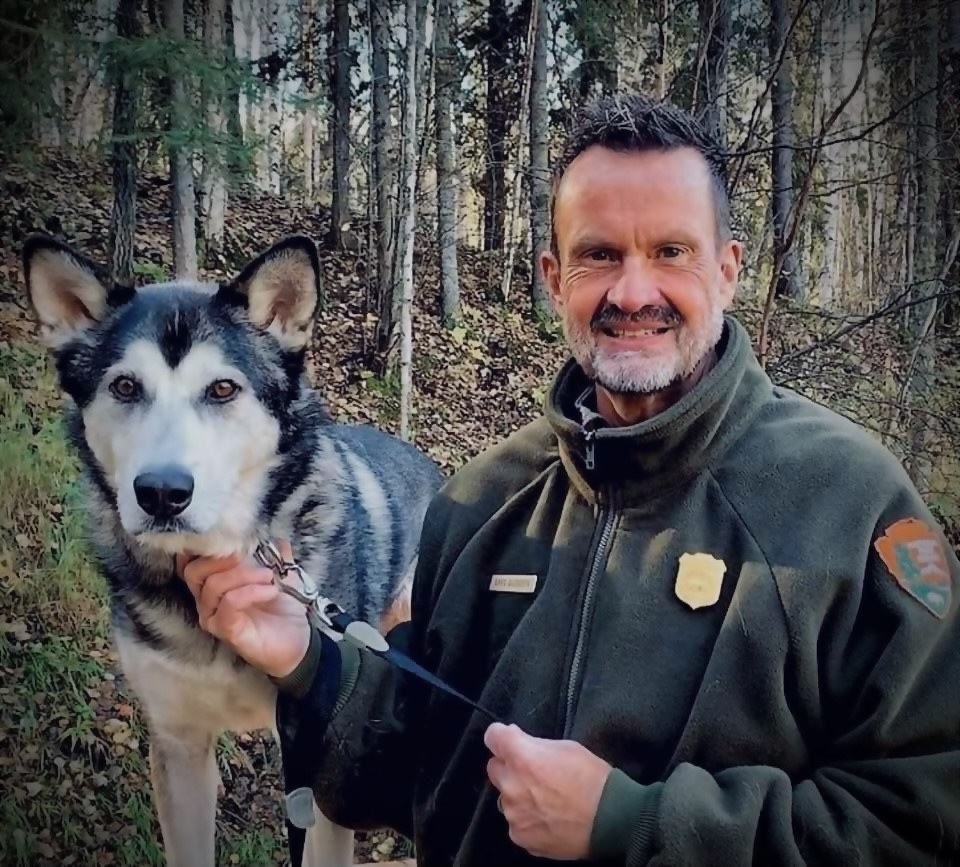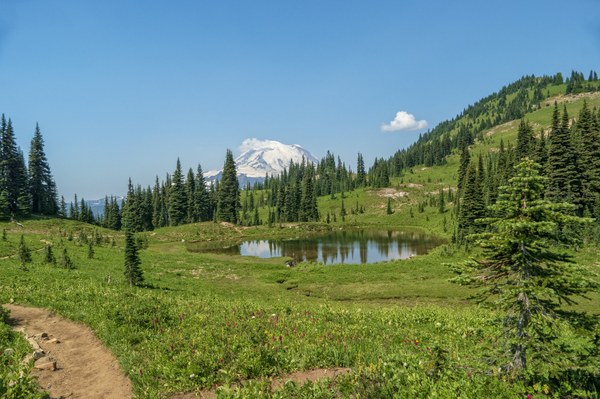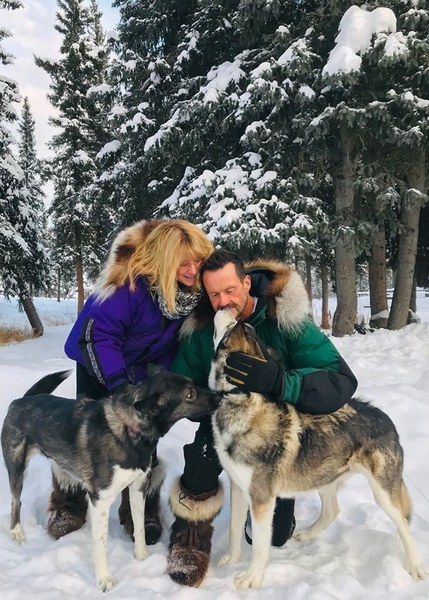
The magic of Mount Rainier has inspired Mountaineers for generations. From our early involvement advocating for wilderness areas and building trails (including the Wonderland Trail) to today’s river of hikers, backpackers, trail runners, and climbers flowing into the park, it has long been one of the most popular and stunningly beautiful recreation destinations in the region.
To celebrate the park and the arrival of new leadership, we sat down with the new Mount Rainier National Park superintendent, Greg Dudgeon. Greg arrived at the mountain in late summer 2021 after extensive National Park Service experience in Alaska. Read on to hear his perspective on current issues facing the park and what he hopes to see in the future.
What drew you to Mount Rainier National Park? In your view, what makes the park special?
My first trip to the Pacific Northwest was back in 1983 while transitioning to Glacier Bay National Park in Southeast Alaska. Seeing Mount Rainier out my window during our flight approach to Seattle is one of those images I will always carry with me. I remember thinking to myself this would be one of the very few places I would consider leaving Alaska for.
My first months in the park have been eye opening. What’s really struck me is how important a place it is to so many people. In my short tenure, I've met a number of folks who have connections to the park and the mountain to a degree that I've never experienced in my 30 some years with the National Park Service. It's a sacred place, it's a special place. To be able to be a part of that is truly an honor.
 Mount Rainier. Photographer unknown.
Mount Rainier. Photographer unknown.
You previously managed Gates of the Arctic National Park and Preserve and the Yukon-Charley Rivers National Preserve. How would you compare managing parks in Alaska to your experience so far at Mount Rainier?
One of the greatest differences is the parks I came from are landscape-scale parks without a lot of infrastructure. Parks where managing wildlife and subsistence use by Alaska Native communities - who are located off the road system - so they can continue their traditional harvest and lifeways is a big piece of the management. At a park like Mount Rainier, many conversations revolve around infrastructure, trails, and providing the facilities visitors need for both safety and comfort, and to enhance their experience. It’s almost like being the mayor of a small community.
What can Mountaineers members do to support staff efforts to preserve the landscape and provide a memorable visitor experience?
The Mountaineers longtime passion and advocacy for national parks and wild landscapes is much needed, appreciated, and encouraged in the future. There are several things you can continue to do to protect and share national parks like Mount Rainier.
The first is to support strong climate action goals as an organization and as individuals. We need to find the aspects of climate change that resonate for each of us and translate that into action that can make an impact for future generations.
I also think the concept of Leave No Trace is critical. It’s an important lifeway and lifestyle. We need to continue to preach it, teach it, and practice it - whether you're in a national park, local park, or your own backyard. Those individual actions scale up to collective action that makes a difference.
A long time ago someone said something to me that really stuck: “national parks belong to all of us, but the special places you find within them will always be your own.” Introduce someone to a new national park or wild space and help them understand what’s so unique and special about these places, and why they're worth protecting.
How do you hope to manage Mount Rainier in the face of challenges rising from climate change?
National parks are special places that don’t stay special by accident. It’s important to use the resources and value of parks to drive home the importance of addressing climate change. I have no doubt that longtime visitors can see the changes in the snowfield and the ice over time.
I believe last fall was the first time the climbing season in the park had to be shortened because of unsafe snow and ice conditions leading to Rainier’s summit. Commercial guides had to stop their seasons, and I don't know if that's ever happened before.
As a National Park Service, we have to do a better job of thinking about where we build and develop infrastructure with tomorrow in mind, and communicating those decisions within a climate context.
 Greg and his wife Susan with their dogs, Lucor and Solace. Both are former "canine rangers" from Denali National Park's working sled dog kennel.
Greg and his wife Susan with their dogs, Lucor and Solace. Both are former "canine rangers" from Denali National Park's working sled dog kennel.
How is the park engaging with Tribal Nations that have cultural and spiritual connections to the areas encompassed by the park?
The people that have been here before have done good work in that regard, but I feel like there's still a lot of potential growth in this area. Later this spring, we'll be meeting formally with all six affiliated tribes of Mount Rainier for the first time since my arrival - the Cowlitz, Muckleshoot, Nisqually, Puyallup, Squaxin Island, and the Yakama.
That formal government-to-government consultation is a big part of what we do, but there’s also a more personal side. I'm looking forward to developing some personal awareness and, hopefully, personal relationships with the people who help lead and shepherd the affiliated tribes.
There are currently two designated use areas for two of the tribes in the park. There is definitely an opportunity to build and promote more resources around land acknowledgment and the concept of “homeland” for those first peoples of the area encompassed by the park.
We want to better understand what messages and stories the affiliated tribes want to convey about this place so visitors to Mount Rainier leave with a better understanding of, and appreciation for, this area as their homeland.
The park reopened access to the Carbon River area in February. What can you share about this area with those who might be interested in visiting?
For the Carbon River area, we’re trying to stabilize what was damaged in storms last November, so that people will be able to access the Ipswich Campground and continue to the Mowich area from Carbon River Road. In light of climate change and a changing landscape, we're anticipating the need to reevaluate what access looks like there long term, and what kind of infrastructure makes the most sense.
If we can provide access in a way that doesn't find itself vulnerable to the changing course of the river and the geologic dynamics, I think we're all better off in the long term, but there’s a real need to let the mountain do what the mountain does.
How is the park working to balance outdoor equity and access with the need to explore new visitor management tools like permits and reservations that can impact equitable access?
I had early conversations with staff that helped me get a handle on what groups we've been reaching out to, and who has been reaching out to us wanting to access the park in a way that’s culturally and experientially meaningful to them.
There are a number of organizations and individuals helping to increase access - whether it's a day trip to the park, working on trails, or becoming a park volunteer. We do what we can to make sure that those partners and organizations don't find the financial piece to be a roadblock to their ability to increase access to the park. We want everyone to leave the park knowing Mount Rainier is their park too.
Learn more by visiting the park’s website nps.gov/mora
Lead image of Greg and Lucor.
This article originally appeared in our summer 2022 issue of Mountaineer Magazine. To view the original article in magazine form and read more stories from our publication in our archives.
 The Mountaineers
The Mountaineers